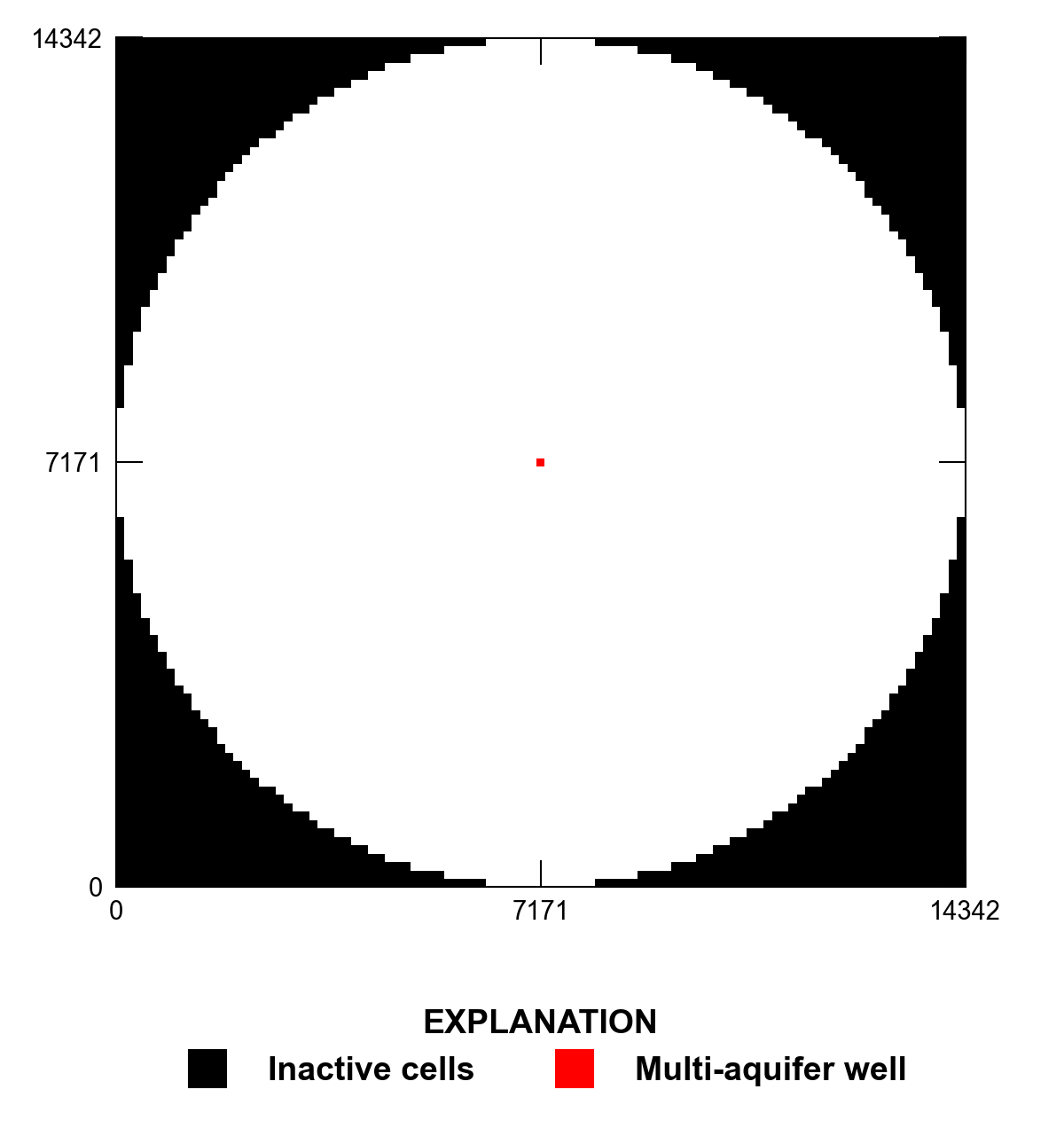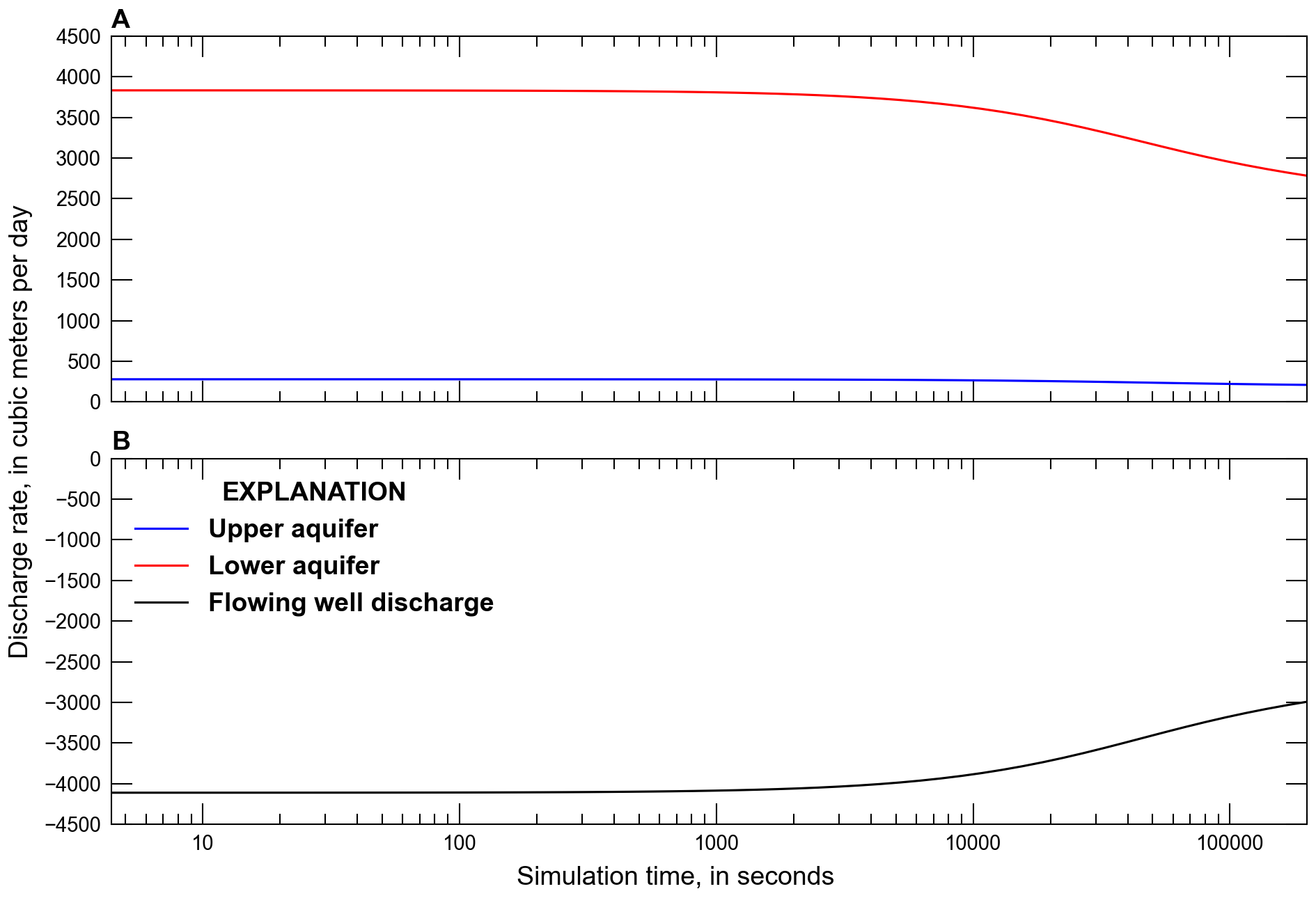15. Multi-Aquifer Well Package Problem 2
This is a modified version of the multi-aquifer well simulation described in (Neville & Tonkin, 2004). The example simulates an upper and lower aquifer separated by an impermeable confining unit but connected by a well that is open across both aquifers. The multi-aquifer well uses the flowing well Multi-Aquifer Well (MAW) Package option to simulate discharge of water from the well at land surface.

Figure 15.1 Location of inactive cells and the multi-aquifer well.
15.1. Example Description
Model parameters for the example are summarized in
Table 15.1. The model consists of a grid of
101 columns, 101 rows, and 2 layers. The model domain is 14,342
\(m\) in the x- and y-directions
(Figure 15.1). The discretization is in the
row and column directions is 142 \(m\). The top of the model is
specified to be -50 \(m\) and the bottom of each layer is specified
to be 142.9 and -514.5 \(m\). Groundwater flow was inactivated
beyond a distance of 7,163 \(m\) from the center cell (row 51,
column 51) in model layers 1 and 2 by specifying an IDOMAIN value of
zero in these cells (Figure 15.1).
One transient stress period 2.1314815 days in length is simulated. The stress period has 50 time steps and uses a time step multiplier equal to 1.2, which results in time step lengths that range \(0.51 \times 10^{-4}\) to \(0.39\) days. A short simulation time is specified to prevent the effect of the well propagating to the model boundary.
Parameter |
Value |
|---|---|
Number of periods |
1 |
Number of layers |
2 |
Number of rows |
101 |
Number of columns |
101 |
Column width (\(m\)) |
142.0 |
Row width (\(m\)) |
142.0 |
Top of the model (\(m\)) |
–50.0 |
Bottom elevations (\(m\)) |
–142.9, –514.5 |
Starting head (\(m\)) |
3.05, 9.14 |
Horizontal hydraulic conductivity (\(m/d\)) |
1.0 |
Vertical hydraulic conductivity (\(m/d\)) |
1.0e-16 |
Specific storage (\(1/d\)) |
1e-4 |
Well radius (\(m\)) |
0.15 |
Well pumping rate (\(m^{3}/d\)) |
0.0 |
The horizontal and vertical hydraulic conductivity is 1 and \(1 \times 10^{-16}\) \(m/d\). The transmissivity of of the upper and lower aquifer is 92.9 and 371.6 \(m^2/d\). A constant specific storage value of \(1 \times 10^{-4}\) (\(1/d\)) is specified. All model layers are specified to be confined. An initial head of 3.05 and 9.14 \(m\) are specified in the upper and lower aquifer, respectively.
The multi-aquifer well was the only boundary condition specified in the model. The well is located in the center of the model domain (Figure 15.1), fully penetrates both aquifers, has a well radius of 0.15 \(m\), and is not pumping. The well conductance is specified to be 111.3763 and 445.9849 \(m^{2}/d\) in the upper and lower aquifer, respectively. The initial head in the well was set equal to the initial head in the lower aquifer (9.14 \(m\)) and well storage is simulated. The flowing well discharge elevation and conductance are specified to be 0.0 \(m\) and \(m^{2}/d\).
15.2. Example Results
Transient results for non-pumping and pumping case are shown in Figure 15.2. Inflow to the well from the upper and lower aquifers is equal to the flowing well discharge. Initially the water level in the well and aquifers is above the flowing well discharge elevation. As a result, flowing well discharge begins immediately and continues throughout the simulation. Flowing well discharge decreases during the simulation as water-levels in the well and in the aquifer adjacent to the well decrease during the simulation.

Figure 15.2 Simulated aquifer discharges to the multi-aquifer well and flowing well discharge. Discharge rates are relative to the multi-aquifer well; positive and negative discharge rates represent inflow to and outflow from the multi-aquifer, respectively. A. Aquifer discharge to the multi-aquifer well. B. Flowing well discharge.
15.3. References Cited
Neville, C. J., & Tonkin, M. J. (2004). Modeling multiaquifer wells with MODFLOW. Ground Water, 42(6), 910–919. https://doi.org/10.1111/j.1745-6584.2004.t01-9-.x
15.4. Jupyter Notebook
The Jupyter notebook used to create the MODFLOW 6 input files for this example and post-process the results is: